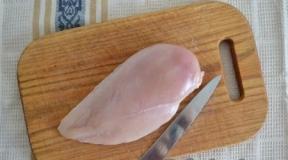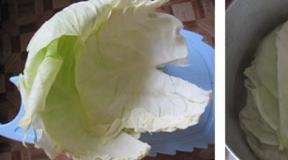Rules for the behavior of children at the table. Lessons in etiquette and good manners
Young parents are not always serious about the advice of their elders in raising children, and teaching their baby the rules of behavior at the table is considered the tenth thing. So it comes down in some families to completely non-pedagogical shouts: “don’t champ, close your mouth and chew, sit up straight, don’t rock in your chair, don’t grab from the table before dinner…”. On this they consider their mission completed. And the grandmother knows for sure that in a few years parents will have to blush for such an undergrowth. Or another situation, the kid has been poking around in the soup for half an hour, choosing from there what he likes best, as a result pushing the plate away, spilling the contents on the floor, on the table and on himself ... A familiar situation? Forgivable if the child is only a year old. What if it's four or five? Where is the line between childish awkwardness and lack of good manners? And when should you start introducing your child to the basics of etiquette? Let's see what the rules of behavior for children at the table should be.
Everyone remembers a few unpleasant moments when a neighbor's teenager or a kid invited to a children's party simply disrupted lunch with their behavior. They talked loudly, stretched across the table for the best piece of cake, slurped, and even choked, not chewing food. The list of unacceptable acts is endless.
Let's protect ourselves from such behavior of a son or daughter in the future. Let's try to systematize the training of our crumbs in good manners, so that it is not burdensome either for them or for us. The best age to start training is 1.5 - 2 years. Naturally, at this age, the child will not be able to understand all the rules of adult etiquette. Yes, this is not necessary.
When to teach? Everything has its time
Table manners for kids are slightly different from adult etiquette, because many hyperactive children become little pranksters during meals. Most children learn good manners before the age of 5. But you need to start teaching a child as early as 1.5 - 2 years. Of course, there may be exceptions to the rules, but be aware that the later you start training, the more difficult your lessons will be for your child.
We read an article on how to teach a child to eat independently and carefully -
from 1.5 to 5
- At this age, the child is actively mastering the skills of the world around him. He absorbs everything he sees, tries to imitate adults. It's time to learn the basics of etiquette in a playful way;
- It is mandatory to wash your hands before eating. Mom herself should not forget to wash her hands before feeding the baby. Before each meal, she should go to the bathroom with the baby and wash her hands and herself and him. Over time, it will do this automatically;
- Feeding the baby should definitely take place at the dinner table, and not in the nursery and not in front of the TV. This will help your child to take food seriously in the future, to respect the work of those who prepare food. Put the baby on a high chair so that he does not look out from under the table, but feels like an equal member of the family;
- Lay a linen napkin on your baby's lap. Clothes will stay clean even if the child spills soup or tea. As an adult, having a napkin in a restaurant will not put your child into a stupor;
- Do not let the child play with food, crumble bread, spread porridge on the table. Such behavior is not permissible even at 2 years old. Try to patiently explain to the baby that it’s ugly to behave like that, that mom is ashamed of him. Mom and dad never act like that. Of course, the baby will not listen to you the first time;
- Only one rule: never yell at him. Be patient and consistent in your demands. It is impossible today to forbid something, and tomorrow not to notice what was created by the child;
- By the age of five, children should already be able to handle a fork and knife, while children's. They should not be confused that the knife should be held in the right hand and the fork in the left hand. By this age, you need to teach the child which foods are eaten with the help of appliances, and which ones are taken by hand.
5 to 10
The most fruitful age for education, but also the most difficult. During this period, the child does not so unconditionally trust the words of the parents. He already independently tries to understand the life and actions of the people around him.
Mom and dad should not allow any indulgence for themselves in the ritual of eating. If you teach a child not to drink juices from a package, but to pour them into a glass, it would be unacceptable to violate this rule yourself. Or just one day forget to wash your hands before dinner. Or not to thank the hostess for dinner. The child will notice this, and your words will no longer be true for him.
(The picture is clickable, you can copy and print)
Moms take note!
Hello girls) I didn’t think that the problem of stretch marks would affect me, but I’ll write about it))) But I have nowhere to go, so I’m writing here: How did I get rid of stretch marks after childbirth? I will be very glad if my method helps you too ...
At 5 - 6 years old, the baby must learn how to behave at the table and no longer violate accepted norms. Each violation must be discussed with the child at the family council. This will help him understand the seriousness of the demands of adults. But in no case should a “debriefing” be carried out in the presence of strangers, in a derogatory manner or with the help of shouting and swearing.
- The kid already knows that you need to sit at the dining table straight, not swaying in a chair. It is unacceptable to spread your elbows and push your neighbors on the table with them. If it is difficult to enforce this rule with words, the reception with books helps a lot. During lunch, stick your child's armpit on a book and ask them to hold them until the end of the meal. A few of these exercises, and there will be no problems with the elbows;
- The child does not allow himself to champ loudly, speak with a full mouth. It was instilled in him constantly. He also knows that you need to put small pieces of food in your mouth and chew them thoroughly;
- The kid is holding back belching and coughing. If this is not possible, he must turn away from the table and cover his mouth with a paper napkin;
- It will be quite natural for a child under 10 years old to know that one cannot consider himself the center of society and attract everyone's attention to his person with various loud demands. If the baby needs to move away from the table, he should ask permission from one of the parents in a quiet voice, calmly. It is not necessary for everyone to know what he wants to go to the toilet;
- You can not reach for a plate at the other end of the table through all the dishes. The child knows that he needs to ask to put the desired piece on his plate. You can’t rummage through a common dish in search of the best piece;
- You can sit down at the table only after adults, and get up after everyone has eaten. If you do not want to sit and listen to the conversations of adults, the child simply asks permission to leave;
- Gratitude for lunch should definitely manifest itself in the form of a magic word “thank you”.
10 and older
You did a good job teaching your offspring excellent manners and etiquette. However, it is too early to relax. He knows what every intelligent person should know and observe. But the rules of good manners and behavior at the table are not limited to this. Ahead is the study of special cutlery that is not used daily. It would be nice to introduce your child to how to eat various exotic dishes. It will not be superfluous to have general knowledge about the food traditions of the peoples of the world.
(The picture is clickable, you can copy and print)
- Don't talk to your child in a didactic tone. For a better assimilation of the rules of etiquette, a game form of training is suitable. You can come up with a dinner party for dolls and bears, setting the table with toy dishes according to all adult standards. Responsible for this dinner, of course, will be your child. And you just prompt and advise in time.
- Be consistent and patient in your learning. Do not allow yourself to take it out on the child, even if he has done something unacceptable. Do not forget to praise and support the child for success.
- Involve your child in preparing dinner. Entrust him to arrange the plates, bring the bread to the table. Working together will bring together and make the baby more respectful of food and the one who cooks dinner.
- Call on cartoons and fairy tales that talk about the rules of etiquette to help you. Discuss with your child the scene you just saw from the movie on the topic. Don't skip real life examples. The rules of behavior at the table should be vividly woven into reality, this is not a frozen dogma.
- Your own example is the best lesson. Children always imitate adults. Let's use this for learning. Of course, it is not easy to always control yourself and not let you grab a piece of delicious food on the fly, but remember about the child.
Why should a child be taught etiquette?
Your efforts will not be in vain. Adult life will very soon become your baby's life. A joint lunch with a potential employer, a visit to a restaurant with a girl you like, a business dinner with partners, a corporate party ... Often the most serious conversations are held at the dinner table. We read an article with comments and experiments
Video minute: table etiquette
Psychologists say that it is necessary to teach a child the rules of etiquette at the table from early childhood: from a year to two:
How to sit at the table
Lessons in good manners. How to behave at the table? How to sit, what can and should not be done at the table? You will learn in the lessons of good manners:
How Koksik and Shunya learned the rules of table manners
Moms take note!
Hello girls! Today I will tell you how I managed to get in shape, lose 20 kilograms, and finally get rid of the terrible complexes of overweight people. I hope the information is useful to you!
This question is asked by people at different ages. By the behavior and ability to use devices, one can judge the culture and upbringing of a person. At all times, special attention was paid to table etiquette. Its rules were not invented in one day, they were formed and changed over the centuries.
All the rules for the use of plates and the position on the table of appliances - forks, spoons, knives, were carefully thought out, based on the convenience and freedom of movement of a person at the table. Knowing the laws of etiquette makes it possible to feel confident not only among friends, but also at a social event. All the subtleties of restaurant etiquette at the table can be easily comprehended in courses on food culture and etiquette. There are also differences in the rules of eating, primarily based on folk traditions, customs, tastes and peculiarities of national cuisine.
Family Etiquette
Even in the circle of the closest relatives, it is necessary to follow the rules of the culture of eating. The elders should sit at the table first, and only then the younger members of the family. Men, in turn, sit down at the table after all the ladies have sat down. You can’t start a meal until the head of the family has started it.
Eating does not accept the speedy eating of all the food on the plate. Talking with a full mouth, waving arms and cutlery, reading a book while eating, reaching across the table for a piece of cheese is considered a complete lack of manners. You can’t get up from the table earlier if the rest of the participants in the feast have not finished the meal.
It is very important in the process of eating to keep your back straight, you need to sit straight, your elbows should not be on the table. Remember that when communicating during a feast, in no case should you turn away from the interlocutors sitting on both sides. It is also not recommended to communicate with anyone through a neighbor.
Paper complications
The napkin, usually nicely folded, shouldn't scare you. Before eating, unfold it and place it on your knees. Only lips and fingers can be wiped with a napkin. Do not wipe your face with it or put it in your pocket at the end of the meal. Roll it up and place it on the side of your plate. If the napkin is on the floor, you do not need to pick it up.
How to use cutlery
Each cutlery has its own function. The spoon should be between the thumb and forefinger. It is not recommended to eat with a spoon those dishes that can be eaten with a fork, for example, side dishes, desserts,  casseroles, etc. A fork should be used to take food from a plate, a knife can be used to touch up food on a plate, and a dish cannot be cut into small pieces to facilitate eating using only a fork. When chewing food, do not wave and gesticulate with a knife and fork, their ends should be directed downward, perpendicular or at an acute angle to the plate.
casseroles, etc. A fork should be used to take food from a plate, a knife can be used to touch up food on a plate, and a dish cannot be cut into small pieces to facilitate eating using only a fork. When chewing food, do not wave and gesticulate with a knife and fork, their ends should be directed downward, perpendicular or at an acute angle to the plate.
Cross your fork and knife on your plate when you want to take a slice of bread or change cutlery. When you have finished eating, the plate does not need to be moved or removed. Fold the cutlery diagonally on the plate - this will symbolize the end of the meal.
First course
There are many nuances associated with eating soup. Do not pour a full bowl of soup, eating it in this case is very inconvenient. You can’t blow on the soup, etiquette allows you to only stir it slightly in a bowl for a very short time.
You need to eat soup from the tip of a spoon, which should be brought parallel to your mouth. Keep your thumb on the handle of the spoon. Eating soup to the last drop is considered extremely indecent, leave some liquid at the bottom of the plate and deflect it away from you, filling the spoon with soup. At the end of the first course, the spoon should remain on the plate. Do not lick and wipe the spoon with a napkin.
Also, you can’t keep a piece of bread in your hand all the time, according to the rules of etiquette, you need to break off small pieces. It is not necessary to spread butter on bread by weight, it is customary to put it on a plate, holding it with your left hand, and spread butter with a knife.
Second course
It is also necessary to be able to eat second or hot dishes correctly. You can not hold the handles of a knife or fork in your fingers, hold them exclusively in your palms. Place your index finger on the base of the knife, in front of the blade. When you are about to cut food, hold your fork and knife at an acute angle, not perpendicular to the table.
Fish and seafood
Cutlery for fish and seafood is smaller than cutlery. Fish follows  cut with a knife and fork, slowly separating small bones on the edge of the plate. It is unacceptable to cut the fish with a knife or try to break it with a fork. Sometimes the bone is on the tongue, in this case, do not spit it into a plate, slowly remove it from your mouth onto a fork and put it on a plate. It is customary to eat seafood with a special fork with two cloves and a sharp knife with a small hole in the blade. Etiquette allows you to eat small crustaceans and shrimp with your hands, but snail meat can only be removed with special tongs, carefully holding the shell with a knife.
cut with a knife and fork, slowly separating small bones on the edge of the plate. It is unacceptable to cut the fish with a knife or try to break it with a fork. Sometimes the bone is on the tongue, in this case, do not spit it into a plate, slowly remove it from your mouth onto a fork and put it on a plate. It is customary to eat seafood with a special fork with two cloves and a sharp knife with a small hole in the blade. Etiquette allows you to eat small crustaceans and shrimp with your hands, but snail meat can only be removed with special tongs, carefully holding the shell with a knife.
Poultry should not be eaten by hand or with a fork. A piece should be held with a fork, cutting small slices with a knife from the bone.
desserts
Cutlery for a variety of desserts is considered especially tricky. Their handles are directed to the right or left, and they are taken according to the direction of the handle, in the right or left hand.
If there is no need to cut a dish, then use only a fork, holding it in your right hand. Help yourself hold dessert with a slice of bread. A special fork is also used to eat asparagus, although some "experts" claim that it can be eaten with your hands. This is an outdated opinion, since since the beginning of the 20th century, asparagus has not been taken off the plate. For tea and coffee, special mugs are used; you should not pour a hot drink to the brim, you risk getting burned.
Knowledge of etiquette is not only a mandatory skill, but also an opportunity to make a lasting impression on others with noble manners and pleasant appearance.
Nuances
6 3 471 0
Each of us knows what "etiquette" is.
This term is divided into several branches, such as: smoking etiquette, table manners, communication etiquette, telephone etiquette and so on.
For the first time, the concept of "rules of etiquette at the table" appeared under King Louis XIV of France, but modern society still adheres to the norms and rules of etiquette. A lot of books have been written about the rules of behavior, the subject “Ethics” will be introduced into the school curriculum, schoolchildren from an early age are taught to behave, the rules of good taste, since this knowledge will undoubtedly be useful to them. About the basic rules of table etiquette below.
General rules
General rules of conduct must be known and remembered in order to give the impression of an educated and confident person. As the saying goes: "Meet by clothes." Depending on how you behave, the attitude towards you will become either positive or negative.
Straight posture.
Sit comfortably, relax your shoulders and arms, but your back should be level and confident;
During the meal, you need to talk only with those who are sitting next to you, you should not speak loudly, referring to a person sitting far from you;
Eating should take place without extraneous sounds.
There is no discussion about the need to understand the culture of food. Let's do without champing, coughing, talking with a full mouth and any sounds;
Elbows on the table are superfluous.
Your elbows on the edge of the table are bad form, however, it is allowed to lower the brushes, but only if you cannot do without it. If you want to try a dish, but hundreds of other delicacies separate you from it, you should not reach for it across the entire table. Quietly turn to a neighbor with a request to pass it to you;
Eat food calmly, measuredly and with taste.
Hunger overshadows your mind and dinner caught you after several hours of waiting, remember that it is not your style to pounce on food;
If the dish that is served to you is too hot, leave it alone, do not blow on it.
Wait for the temperature to drop by itself;
In no case do not fix your makeup or hair while sitting at the table.
If you feel that you need it, apologize to those present and leave for a couple of minutes.

Family dinner
In fact, the rules of conduct at the table at a family dinner and in a restaurant are different.
At a family dinner visiting friends, the rules of etiquette are a little softer, since people are close to you and they may forgive or not notice some of your mistakes.
Nevertheless, it is necessary to be on the alert and adhere to the rules that we will now recall:
- Be sure to praise the treat, the hostess will be flattered that her efforts were appreciated;
- Don't wait for the hosts to entertain you. Keep up the conversation, joke, tell funny stories from your life, but make sure that the dialogue does not turn into a monologue;
- Do not discuss politics, money and illness. Such topics at the table are inappropriate, moreover, a healthy tone of conversation can turn into a quarrel;
- If there are strangers in the company, wait until the owner introduces you to each other. It happens that a person did not make a good impression on you, then do not enter into a conflict. Be at ease and polite, because if he is among those invited, it means that the owners wanted to see him that day;
- If you feel like you need to use a toothpick, don't give preference to your tongue. Firstly, it looks disgusting, the expression of a person's face changes. Secondly, during the process, you can make obscene sounds. The best thing is to get by with a toothpick, very quickly and, if possible, imperceptibly;
- Do not take food from a common plate with your appliances. For this, there are common spoons, spatulas and tongs;
- You should not persistently offer your neighbor (and even worse - everyone present) a dish that you liked. Be sure that all guests know what dishes are on the table, they are able to take care of themselves;
- In order not to offend the hostess, try everything that she offered as lunch. If a dish does not meet your expectations, carefully leave it on the edge of the plate. Eat only what you like and in moderation;
- If you doubt your skills, just behave like others.

A restaurant
Another thing is lunch at a restaurant. As a rule, such a lunch can be business, with work colleagues or with management. Your career depends on the impression you make. On the other hand, lunch or dinner at a restaurant can be part of your date with your significant other.
- If a man invited a girl to a restaurant, he is obliged to offer her some dishes from the menu. It is considered bad form for a girl to show her disinterest, she should take part in the choice of dishes;
- If you came to the restaurant with a large company, you need to start eating when all the participants in the feast have taken out the dishes. If someone is waiting for their order, with his permission, the rest can start the meal;
- If you have become a member of a business dinner, being an active user of Instagram, it would be better if you refrain from having to take a picture of your dinner. Such actions would be excusable in the company of close friends;
- The ingredient of the dish that you cannot chew can be carefully returned to the fork, and then discreetly sent to the edge of the plate;
- Did you drop your fork? Do not worry - contact the waiter with a request to replace it with another one, do not lift it yourself;
- Get rid of the habit of loudly calling the waiter, and also do not snap your fingers, do not whistle, and do not bang the spoon on the glass. You can invite the waiter to the table with a nod or a slight wave of your hand, showing him that you treat him with respect. Finger snapping and whistling will not only worsen the impression of you, but also increase your chances of becoming the lucky owner of the secret ingredient in a drink or dish;
- You should not discuss in front of the waiter which of you will pay for dinner. It is necessary to agree on this in advance;
- If you are satisfied with the quality of food and drinks, thank the waiter verbally, then leave a generous tip.

Cutlery
Rules of conduct at the table, topics that should and should not be discussed - these are important knowledge that is necessary for a successful dinner or lunch in a decent company. However, every self-respecting person should know the rules for eating, namely, how to handle appliances.
- The left hand is a fork, the right hand is a knife. If you, for example, eat meat - do not cut the whole piece, gradually cut off small pieces with a knife, sending them into your mouth with a fork, otherwise the meat will cool quickly;
- Fish cannot be cut with a knife, a knife is necessary to separate the bone. If you still come across a bone, you can carefully use a napkin, but in no case with your hands;
- The first dish should be eaten, scooping a spoon away from you. At the end, when you are already finishing the dish, tilt the plate away from you;
- You can put salads from a common plate into your own with a special salad spoon, and use a fork. Salads cannot be cut with a knife;
- So, you want to try a sandwich. A piece of bread should be in your left hand, in your right hand there will be a knife with which you can spread the filling on the bread. They do not bite a sandwich, but use appliances;
- A piece of bread cannot be bitten off, it is necessary to break off small slices with your fingers;
- You feel that you need to interrupt your meal - put the utensils as if they were in your hands. To the right is a knife, and a fork to the left on the edge of the plate. At the end of dinner, the cutlery should lie crosswise, then the waiter will understand that your dinner is over.

How to drink alcohol
You already know what to talk about at the table, how to behave with a lady and hosts at a friendly dinner, how to use appliances. However, the drinking culture is very developed in Europe, so we will tell you how to drink alcoholic beverages correctly.
- Before the start of the meal, guests are served an aperitif - a light alcoholic drink that stimulates the appetite;
- In the women's company, the mistress of the house fills the glasses, otherwise it is the man;
- Wait until your neighbor finishes drinking, do not top up his glass and do not rush him;
- If the guest has left, his glass should remain empty;
- It is considered bad form to uncork bottles at the table. The exception is sparkling wine or champagne;
- Vodka, to the surprise of our compatriots, according to the rules of etiquette, is drunk with ice, in small sips and as a digestif. It is believed that a well-fed person does not get drunk;
- Eat first, drink later. You can not drink alcohol with food;
- Drink in the same rhythm as the rest of the guests. Don't rush anyone, but if you feel like you've had enough, stop;
- Enjoy alcoholic drinks. Inhale the aroma, appreciate the color saturation. Alcohol should bring pleasure, for this, treat alcohol carefully and responsibly.

Video to the material
If you see an error, please highlight a piece of text and click Ctrl+Enter.
A person's culture can be judged by how he behaves at the table. Unfortunately, not everyone knows these rules and some do not even try to adhere to them, but we will not talk about uncultured people, but we will talk about us, about cultured ones. Times change and some rules have outlived their own, but the main ones remain unchanged. Even if you do not know how to behave at the table, and are not accustomed to the rules of etiquette of food, then it is still desirable to learn how to use cutlery, who knows, maybe you will someday get to dinner at Buckingham Palace ...
Etiquette is the historically established rules of human behavior in society. These rules are usually very much intertwined with the culture and national tradition of the people, they are built on respect, courtesy and attention to each other. The rules of etiquette provide for the ability to behave at the table and use cutlery for its intended purpose. Let's get acquainted with some of them.
How to behave at the table or rules of etiquette
Rule 1 . When you sit down at the table, pay attention to your posture. Sit freely, you can lean lightly on the back of the chair. The chair should not be too close to the table, otherwise you will want to put your elbows, do not put it far either, while eating it will be inconvenient for you to dine.
Rule 2 . If you sat down at the table and do not know where to put your hands, the main thing is to keep them away from your face, do not rub your forehead, do not prop your chin. Lay them loose on your knees.
Rule 3 . Sometimes a person does not know what to do with a napkin and literally does not notice it. The napkin must be put on your knees, just do not wipe your lips and hands with it, because there are paper napkins for this. When you want to leave the table, put the napkin to the right of the plate.
Rule 4 .If you do not know how to eat a served dish that is unfamiliar to you, then see how its hostess will handle it or ask her what it is made of and how it can be eaten.
Rule 5 . If you accidentally drop your fork or knife, then do not try to pick it up yourself, just ask for another device. And if suddenly this happened to someone around you, then try not to notice it.
Rule 6 . It is extremely indecent to smoke at the table, as well as to arrange a smoke break between serving dishes. This fact is perceived as disrespect for the owners. And besides, the smell of cigarette smoke interrupts the taste of the dishes, because a lot of effort has been spent on them. Smoking is allowed only before coffee. In a very extreme case, between the final course and dessert, at this point there is usually a change of cutlery.
Rule 7 . At the table, try to behave in such a way as not to displease others: drink and eat silently, and do not open your mouth wide, elbows should be pressed to the body and do not bend over the table.
How to properly use cutlery
Cold appetizers are eaten with a fork and knife; hot fish is eaten with a fish fork and knife; meat hot dishes - with a fork and a table knife; all dessert dishes - with a spoon; and fruits - with the help of a fruit knife and fork.
If you are already familiar with all this and know how to behave at the table, then you can just relax or
Master4ef
The rules of good manners at the table are instilled in us from early childhood. Knowing how to behave during a meal gives us self-confidence and the opportunity to show our best in society.
Norms and prohibitions in behavior while eating
- Most importantly, never talk with your mouth full. Not only does this look unaesthetic, but it also prevents you from expressing your opinion clearly.
- No need to try to bite as much as possible at a time. With a mouthful of food, you will not only look ugly, but also make you look like an ill-mannered person.
- It is also better to forget about the habit of biting bread. Bakery products should be broken off in small portions and put in the mouth.
- It is also important to remember that a meat dish does not need to be cut all at once. Only after eating one piece, you can cut off the next one.
- You can use your hands for poultry dishes if you hold a knife and fork with them.
- Fish bones also need to be pulled out with a fork. In rare cases, you can do it by hand. After that, they need to be wiped with a napkin, and not licked, as ill-mannered people do.
- Garnishes can be pricked on a fork, helping yourself with a piece of bread.
- If the dish is made from minced meat and they can be broken with a fork, then the knife can not be used.
- Eating with a knife is not only dangerous (you can get hurt), but also extremely indecent.
- Once again, we recall such an important nuance as the fork in the left hand, and the knife in the right. Even if you are so uncomfortable, it is worth practicing at home in advance. Confidence comes with practice.
- Do not use a spoon if the dish can be eaten with a fork.
- If you were served compote, then spitting the bones from the fruit directly into the plate is not the best idea. To begin, bring the spoon close to your mouth to spit out the bone before placing it on your plate.
- Do not show your greed and take the biggest pieces. From a common plate, you should always take the piece that lies closest to you.
- In order not to embarrass your table neighbors, do not move dirty dishes towards them.
- It is not customary to stretch across the entire table to the dish you like. Ask for it to be served to you.
- Bad habits like smearing leftover sauce or drinking it off the plate are also off limits.
- Always eat with your mouth closed to avoid making unpleasant sounds.
- Dirty cutlery should not be placed on the tablecloth. Leave them on the plate.
- Also, be careful not to send a tablespoon completely into your mouth.
- In no case, at the end of the meal, you can not lick the spoon, and even more so the plate.
- After you have stirred the sugar in the tea, the spoon should be removed from the cup.
- When serving a dish, do not pick at it, trying to see what it consists of, do not sniff or look closely at it.
- Even if you don't like the food at all, don't say it directly. It's best to refrain from commenting.
- In order not to be disrespectful to the rest of the people sitting at the table, sit up straight, do not cross your legs.
Rules for using napkins at the table
- If the napkin is made of fabric, then its purpose is solely to protect clothing from contamination. I do not need to wipe the dishes with such a napkin, wipe my massive lips or hands.
- There are paper napkins on the table to clean hands and lips.
- After eating, a cloth napkin is left on the side near the plate. Paper put on a plate rolled up.
It should be borne in mind that you can sit down at the table only after the invitation of the hostess. The duty of men is to help all women by pulling back a chair for each. You also need to make sure that your back is always straight. Do not stretch your legs under the table, do not put your elbows on the table - all this will not have the best effect on your reputation.
How to use cutlery
The ability to use cutlery is an integral part of the correct behavior at the table.
- If you still can’t remember the purpose of each of the devices, then use them in the order in which they are decomposed. Starting from the edges to the center.
- In order to put yourself something from a common plate, you need to use those devices that lie near this dish.
- When there is a change of dishes and a pause in the meal, the fork and knife are placed crosswise.
- At the end of the meal, the cutlery is placed on the plate in parallel.

Proper table manners includes much more than the above points. It is important to know not only table etiquette and be able to use cutlery, but also to monitor your manners, behavior and ability to keep up a conversation.
Rules of behavior at the table for children




















